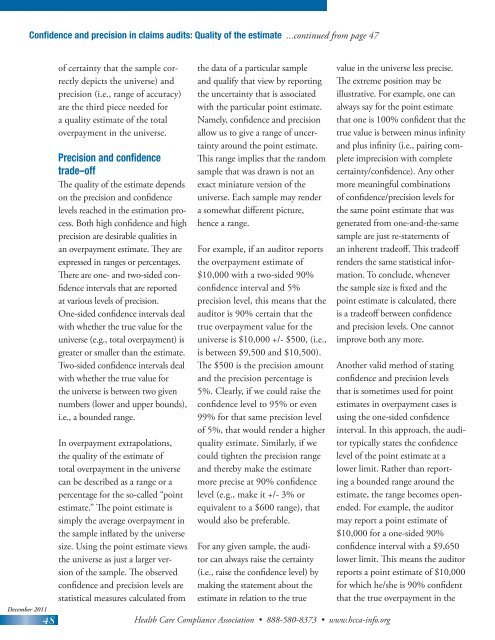Quality of the estimate. December, p. 47 - Health Care Compliance ...
Quality of the estimate. December, p. 47 - Health Care Compliance ...
Quality of the estimate. December, p. 47 - Health Care Compliance ...
You also want an ePaper? Increase the reach of your titles
YUMPU automatically turns print PDFs into web optimized ePapers that Google loves.
Confidence and precision in claims audits: <strong>Quality</strong> <strong>of</strong> <strong>the</strong> <strong>estimate</strong> ...continued from page <strong>47</strong><br />
<strong>December</strong> 2011<br />
48<br />
<strong>of</strong> certainty that <strong>the</strong> sample correctly<br />
depicts <strong>the</strong> universe) and<br />
precision (i.e., range <strong>of</strong> accuracy)<br />
are <strong>the</strong> third piece needed for<br />
a quality <strong>estimate</strong> <strong>of</strong> <strong>the</strong> total<br />
overpayment in <strong>the</strong> universe.<br />
Precision and confidence<br />
trade–<strong>of</strong>f<br />
The quality <strong>of</strong> <strong>the</strong> <strong>estimate</strong> depends<br />
on <strong>the</strong> precision and confidence<br />
levels reached in <strong>the</strong> estimation process.<br />
Both high confidence and high<br />
precision are desirable qualities in<br />
an overpayment <strong>estimate</strong>. They are<br />
expressed in ranges or percentages.<br />
There are one- and two-sided confidence<br />
intervals that are reported<br />
at various levels <strong>of</strong> precision.<br />
One-sided confidence intervals deal<br />
with whe<strong>the</strong>r <strong>the</strong> true value for <strong>the</strong><br />
universe (e.g., total overpayment) is<br />
greater or smaller than <strong>the</strong> <strong>estimate</strong>.<br />
Two-sided confidence intervals deal<br />
with whe<strong>the</strong>r <strong>the</strong> true value for<br />
<strong>the</strong> universe is between two given<br />
numbers (lower and upper bounds),<br />
i.e., a bounded range.<br />
In overpayment extrapolations,<br />
<strong>the</strong> quality <strong>of</strong> <strong>the</strong> <strong>estimate</strong> <strong>of</strong><br />
total overpayment in <strong>the</strong> universe<br />
can be described as a range or a<br />
percentage for <strong>the</strong> so-called “point<br />
<strong>estimate</strong>.” The point <strong>estimate</strong> is<br />
simply <strong>the</strong> average overpayment in<br />
<strong>the</strong> sample inflated by <strong>the</strong> universe<br />
size. Using <strong>the</strong> point <strong>estimate</strong> views<br />
<strong>the</strong> universe as just a larger version<br />
<strong>of</strong> <strong>the</strong> sample. The observed<br />
confidence and precision levels are<br />
statistical measures calculated from<br />
<strong>the</strong> data <strong>of</strong> a particular sample<br />
and qualify that view by reporting<br />
<strong>the</strong> uncertainty that is associated<br />
with <strong>the</strong> particular point <strong>estimate</strong>.<br />
Namely, confidence and precision<br />
allow us to give a range <strong>of</strong> uncertainty<br />
around <strong>the</strong> point <strong>estimate</strong>.<br />
This range implies that <strong>the</strong> random<br />
sample that was drawn is not an<br />
exact miniature version <strong>of</strong> <strong>the</strong><br />
universe. Each sample may render<br />
a somewhat different picture,<br />
hence a range.<br />
For example, if an auditor reports<br />
<strong>the</strong> overpayment <strong>estimate</strong> <strong>of</strong><br />
$10,000 with a two-sided 90%<br />
confidence interval and 5%<br />
precision level, this means that <strong>the</strong><br />
auditor is 90% certain that <strong>the</strong><br />
true overpayment value for <strong>the</strong><br />
universe is $10,000 +/- $500, (i.e.,<br />
is between $9,500 and $10,500).<br />
The $500 is <strong>the</strong> precision amount<br />
and <strong>the</strong> precision percentage is<br />
5%. Clearly, if we could raise <strong>the</strong><br />
confidence level to 95% or even<br />
99% for that same precision level<br />
<strong>of</strong> 5%, that would render a higher<br />
quality <strong>estimate</strong>. Similarly, if we<br />
could tighten <strong>the</strong> precision range<br />
and <strong>the</strong>reby make <strong>the</strong> <strong>estimate</strong><br />
more precise at 90% confidence<br />
level (e.g., make it +/- 3% or<br />
equivalent to a $600 range), that<br />
would also be preferable.<br />
For any given sample, <strong>the</strong> auditor<br />
can always raise <strong>the</strong> certainty<br />
(i.e., raise <strong>the</strong> confidence level) by<br />
making <strong>the</strong> statement about <strong>the</strong><br />
<strong>estimate</strong> in relation to <strong>the</strong> true<br />
<strong>Health</strong> <strong>Care</strong> <strong>Compliance</strong> Association • 888-580-8373 • www.hcca-info.org<br />
value in <strong>the</strong> universe less precise.<br />
The extreme position may be<br />
illustrative. For example, one can<br />
always say for <strong>the</strong> point <strong>estimate</strong><br />
that one is 100% confident that <strong>the</strong><br />
true value is between minus infinity<br />
and plus infinity (i.e., pairing complete<br />
imprecision with complete<br />
certainty/confidence). Any o<strong>the</strong>r<br />
more meaningful combinations<br />
<strong>of</strong> confidence/precision levels for<br />
<strong>the</strong> same point <strong>estimate</strong> that was<br />
generated from one-and-<strong>the</strong>-same<br />
sample are just re-statements <strong>of</strong><br />
an inherent trade<strong>of</strong>f. This trade<strong>of</strong>f<br />
renders <strong>the</strong> same statistical information.<br />
To conclude, whenever<br />
<strong>the</strong> sample size is fixed and <strong>the</strong><br />
point <strong>estimate</strong> is calculated, <strong>the</strong>re<br />
is a trade<strong>of</strong>f between confidence<br />
and precision levels. One cannot<br />
improve both any more.<br />
Ano<strong>the</strong>r valid method <strong>of</strong> stating<br />
confidence and precision levels<br />
that is sometimes used for point<br />
<strong>estimate</strong>s in overpayment cases is<br />
using <strong>the</strong> one-sided confidence<br />
interval. In this approach, <strong>the</strong> auditor<br />
typically states <strong>the</strong> confidence<br />
level <strong>of</strong> <strong>the</strong> point <strong>estimate</strong> at a<br />
lower limit. Ra<strong>the</strong>r than reporting<br />
a bounded range around <strong>the</strong><br />
<strong>estimate</strong>, <strong>the</strong> range becomes openended.<br />
For example, <strong>the</strong> auditor<br />
may report a point <strong>estimate</strong> <strong>of</strong><br />
$10,000 for a one-sided 90%<br />
confidence interval with a $9,650<br />
lower limit. This means <strong>the</strong> auditor<br />
reports a point <strong>estimate</strong> <strong>of</strong> $10,000<br />
for which he/she is 90% confident<br />
that <strong>the</strong> true overpayment in <strong>the</strong>

















